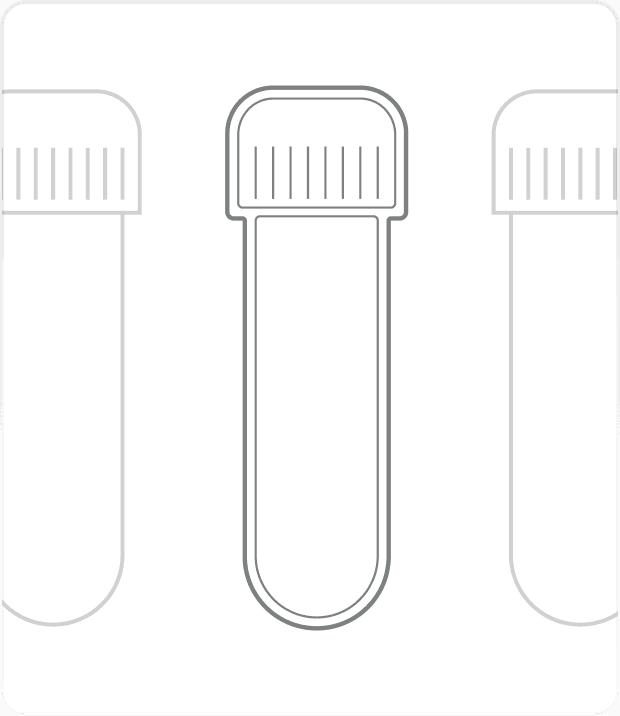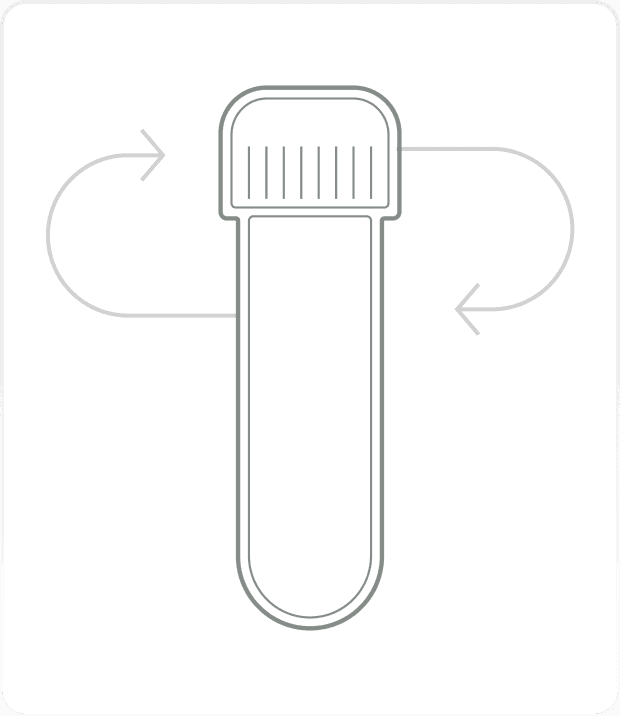What we test
Check out the lists of analyzed biomarkers, and your resulting personalized guidance.

01

First health check
A first comprehensive test with over 100+ biomarkers analyzed.100+ analyzed biomarkers

02

Personalized action plan
Tailored recommendations based on your results to help improve your health.5 pillars clearly defined

03

Follow-up check
6 months after the first check, a second test to compare and track your progress.60+ analyzed biomarkers
What we test
ALL BIOMARKERS
100+ FULL PANEL
60+ LIGHT PANEL
Heart and vascular health17
Hematology12
Immunity & Inflammation10
Kidney Health10
Liver Health14
Metabolic Health7
Nutrients & Oxidative Stress13
Sex Hormones9
Stress & Recovery3
Thyroid health4
Urine analysis7
Uric acid
Uric acid is a biomarker produced during the breakdown of purines, which are compounds found in many foods and naturally in the body. It acts as an antioxidant (a substance that prevents damage from free radicals) at moderate levels but can cause health issues like gout (a type of arthritis) and kidney problems when elevated
SystemHeart and vascular health

Apolipoprotein B (ApoB)
Apolipoprotein B (ApoB) is a protein found in **atherogenic lipoproteins** (like LDL and VLDL), which are linked to **atherosclerosis** (the buildup of plaque in arteries). Each particle of these lipoproteins contains one ApoB molecule, making it a direct measure of the number of these particles in the blood
SystemHeart and vascular health

Apolipoprotein A1
Apolipoprotein A1 (ApoA-1) is the main protein component of high-density lipoprotein (HDL), which helps remove excess cholesterol from the bloodstream. It plays a crucial role in cardiovascular health and has anti-inflammatory properties
SystemHeart and vascular health

Total Cholesterol
Total cholesterol is a lipid (fat) molecule found in the blood, essential for building cell membranes and producing hormones. It exists in various forms, including low-density lipoprotein (LDL) and high-density lipoprotein (HDL), which play different roles in cardiovascular health.
SystemHeart and vascular health

HDL cholesterol
HDL-Cholesterol, often referred to as 'good cholesterol,' is a component of high-density lipoproteins (HDL), which are protein-lipid nanoparticles. HDL plays a crucial role in removing excess cholesterol from cells and transporting it to the liver for excretion, thereby helping to prevent atherosclerosis (the buildup of plaque in arteries).
SystemHeart and vascular health

Non-HDL cholesterol
Non-HDL cholesterol represents all cholesterol that is not carried by high-density lipoprotein (HDL). It includes LDL, VLDL, and other atherogenic lipoproteins. This measurement is considered a better predictor of cardiovascular risk than LDL cholesterol alone, as it captures all potentially harmful cholesterol particles.
SystemHeart and vascular health

LDL cholesterol
LDL-Cholesterol (LDL-C) is a type of cholesterol found in the blood, often referred to as 'bad' cholesterol. It plays a crucial role in the development of atherosclerosis (the buildup of plaque in arteries), which can lead to cardiovascular diseases
SystemHeart and vascular health

Triglycerides
Triglycerides are a type of fat found in the blood, often used as a biomarker for cardiovascular health. They are a key component of lipids (fats) and are crucial for energy storage and metabolism. Elevated levels can indicate increased risk of heart disease and other metabolic issues.
SystemHeart and vascular health

Lipoprotein (a)
Lipoprotein(a) is a type of low-density lipoprotein (LDL) that includes apolipoprotein(a), which is linked to increased cardiovascular risk. It is similar to LDL but has unique properties due to its apolipoprotein(a) component, which influences its pathogenic potential
SystemHeart and vascular health

Erythrocyte fatty acid profile
The erythrocyte fatty acid profile analyzes the fatty acid composition of red blood cell membranes, providing a reliable assessment of long-term dietary fat intake and metabolism. It reflects cellular membrane health and can identify deficiencies in essential fatty acids that impact cardiovascular and neurological health.
SystemHeart and vascular health

Oxidized LDL
Oxidized LDL is a modified form of low-density lipoprotein that has undergone oxidative damage. It's highly atherogenic and plays a key role in the development of atherosclerosis by promoting inflammation and plaque formation. Elevated levels indicate increased cardiovascular risk and oxidative stress.
SystemHeart and vascular health

ApoB / ApoA1
The ApoB/ApoA1 ratio is a biomarker that compares the levels of apolipoprotein B (ApoB) and apolipoprotein A1 (ApoA1) in the blood. ApoB is associated with 'bad' cholesterol, while ApoA1 is linked to 'good' cholesterol. This ratio helps assess cardiovascular risk by measuring the balance between atherogenic (harmful) and protective lipoproteins
SystemHeart and vascular health

TG / HDL‑C (Triglycerides/HDL)
The TG/HDL-C ratio compares triglycerides to HDL cholesterol levels, serving as an indicator of cardiovascular risk and insulin resistance. Higher ratios suggest increased risk of metabolic syndrome, diabetes, and heart disease. Values above 3.5 are considered elevated risk.
SystemHeart and vascular health

Atherogenic Plasma Index (AIP)
The Atherogenic Plasma Index (AIP) is a calculated ratio of triglycerides to HDL cholesterol that assesses cardiovascular risk. Higher AIP values indicate increased risk of atherosclerosis and coronary heart disease. It's particularly useful for identifying small, dense LDL particles that are more atherogenic.
SystemHeart and vascular health

Non-HDL-C
Non-HDL-C represents all atherogenic cholesterol particles by subtracting HDL from total cholesterol. It includes LDL, VLDL, and other potentially harmful lipoproteins. This marker is particularly useful when triglycerides are elevated, as it provides better cardiovascular risk assessment than LDL alone.
SystemHeart and vascular health

LDL-C / HDL-C
The LDL-C/HDL-C ratio compares 'bad' cholesterol to 'good' cholesterol, providing insight into cardiovascular risk. Higher ratios indicate increased risk of atherosclerosis and coronary artery disease. Optimal ratios are typically below 2.5, with lower values indicating better cardiovascular protection.
SystemHeart and vascular health

ApoB / LDL-C
The ApoB/LDL-C ratio compares apolipoprotein B to LDL cholesterol, helping assess the number versus size of LDL particles. Higher ratios indicate more small, dense LDL particles which are more atherogenic. This ratio provides additional cardiovascular risk stratification beyond standard lipid panels.
SystemHeart and vascular health

We provide additionnal services to help you act deeper on your health.
Get access to Europe's most
comprehensive health check
A single checkup as a starting point
60+ biomarkers light panel to start learning from your biology
Two complete checkups a year
100+ biomarkers on your first check, with a targeted follow-up six months later
Wearables integrations
Connect your wearables (Garmin, Withings, Strava, Apple Watch) for consistent feedback on your progress
Tailored actions
From what to eat to how to train: improve your lifestyle everyday and see lasting changes
Getting started
Lab visits
What does a Lucis membership include?
Here's what's included:<br /><br />• **1 complete and 1 follow-up biological assessment per year**, done in partner labs, covering **100+ biomarkers**.<br />• **Simplified health scores** that help you understand key pillars such as **inflammation, energy, metabolism, and hormones**.<br />• **Your private Lucis dashboard**, where you can explore your results, track progress, and access personalized insights.<br />• **A personalized action plan from our medical team**, with guidance to improve your **nutrition, supplementation, sleep, physical activity, environment,** and **mental health**.<br />• **Educational content** to help you understand how your body works and make informed changes.<br />• Option to purchase additional tests<br /><br />Lucis doesn't replace medical diagnosis or prescriptions.
Who can be a Lucis member
Lucis is for people aged 18 and older. Understanding your body's trends gives you the power to make informed decisions about your future. Please note that Lucis is not a medical platform and doesn't replace medical diagnosis or prescriptions.
How does my Lucis membership work?
Once a Lucis member, you'll receive instructions to plan your first blood draw within 24 hours. Then, we send a home collection kit to use the morning of the test.<br />Expect an update timeline in your private dashboard with all required instructions at every step. You'll be notified when lab processing is complete, as the results will be available within 5 weeks after your lab test.
Which tests are included with a Lucis membership?
Lucis membership includes access to 100+ lab tests to measure your current health status, metabolism, sexual hormones, stress and recovery etc. Add-on tests may be available for an additional cost beyond your full membership. See full list of analysis [here](https://www.lucis.life/fr/biomarkers)
Are my health data secured and reliable?
Yes. Over the process, we ensure analytical quality with certified partner laboratories including Eurofins' network. Lucis coordinates standardized workflows with clear labeling, refrigeration, and transport guidance to protect sample integrity.<br /><br />Your data are encrypted, HDS-certified, and compliant with GDPR. Health data are strictly confidential and only shared with you and Lucis' medical team with your explicit consent.





